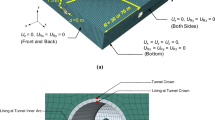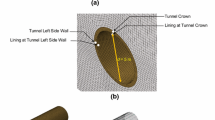Abstract
Tunnels are key elements in modern traffic networks. Large-scale accidents and malicious threats, such as fires or explosions creating a blast loading, potentially carry very high economical and societal consequences. Compared to other statistically certain events, explosive-induced blasts in tunnels have an extremely low probability of occurrence but at the same time an enormous damage potential for structure, life, and environment. The paper presents a procedure for evaluation consequences of blast loading threat scenarios, focusing on the local and global structural integrity of tunnel constructions. Methods to capture the dynamic loading and the structural resistance, especially considering the dynamic soil response under large stresses and strains, are described. For that, a combined experimental and numerical approach is chosen, including characterization of the soil by dynamic triaxial experiments realizing stress levels of about 1 MPa, acting in 1 ms on the specimen. The analysis showed that the measured triaxial strength of the soil differed from the static by a factor of 2 for the friction angle. Furthermore, scaled experiments have been designed and conducted to demonstrate and investigate the behavior of a buried tunnel segment under blast loading. The results showed that realistic loading charges can cause massive cracking of the tunnel system and a soil sinking of up to 1 cm. Both experimental results obtained from the triaxial tests on the one hand and from the scaled tunnel experiments on the other hand have been validated using numerical models. The good agreement obtained is the essential input parameter for the evaluation of criticality in tunnels under blast loading scenarios.

















Similar content being viewed by others
References
Fridolf K, Nilsson D, Frantzich H (2013) Fire evacuation in underground transportation systems: a review of accidents and empirical research. Fire Technol 49:451–475. doi:10.1007/s10694-011-0217-x
Vollmann G, Thewes M, Heimbecher F (2012) Safety and security of underground infrastructure—new concepts for evaluating and mitigating risks of tunnels. In: Proceedings of the 7th International Symposium on Safety and Security of Tunnels (ISTSS), New York City
Choi S, Brinckerhoff P (2012) Protective design guideline of tunnels. In: Proceedings of the 7th International Symposium on Safety and Security of Tunnels (ISTSS), New York City
Vollmann G, Kamarianakis S, Thewes M (2014) Quantitative risk and criticality assessment for tunnels under explosive and fire threat scenarios. In: International Symposium on Tunnel Safety and Security, Marseille
Smith P, Hetherington J (1994) Blast and ballistic loading of structures. Butterworth Heinemann, Oxford
Lönnqvist L (1993) The effects of high explosives in contact with reinforced concrete plates. In: International Symposium on Interaction of Nonnuclear Munitions with Structures
Gebbeken N, Greulich S, Pietzsch A, Landmann F (2004) The engineering tool XPLOSIM to determine the effects of explosive loadings on reinforced and fibre reinforced concrete structures. In: International Symposium on Military Aspects of Blast and Shock
Riedel W, Thoma K, Mayrhofer C, Stolz A (2010) Engineering and numerical tools for explosion protection of reinforced concrete. Int J Protect Struct 1:85–102
Lua Y, Wanga Z, Chong K (2005) A comparative study of buried structure in soil subjected to blast load using 2D and 3D numerical simulations. Soil Dyn Earthq Eng 25:275–288
Gebbekem N, Ruppert M (1999) On the safety and reliability of high dynamic hydrocode simulations Int J Numer Methods Eng 46:839–851
Mayrhofer C (1996) Druckausbreitung vom Räumen—Dipole East (Pressure propagation of rooms - dipole east). Fraunhofer Institut für Kurzzeitdynamik, Ernst-Mach-Institut, Efringen-Kirchen
Baker W, Cox PA, Westine PS, Kulesz JJ, Strehlow RA (1983) Explosions hazards and evaluation. Elsevier, Amsterdam
Weerheijm J, Stolz A, Riedel W, Mediavilla J (2012) Modelling loadings and break-up of RC structure due to internal explosion of fragmenting shells. In: MABS Military Aspect of Blast and Shock, Bourges, France
Gronsten G, Berglund R, Carlberg A, Forsén R (2009) Break-up tests with small ammunition houses using cased charges—Kasun III, FOI-R–2479-SE
Lindholm U (1964) Some experiments with the split Hopkinson pressure bar. J Mech Phys Solids 12:317–335
Gtote D, Park S, Zhou M (2001) Dynamic behavior of concrete at high strain rates and pressures: I. experimental characterization. Int J Impact Eng 25:869–886
Malvar L, Crawford J (1998) Dynamic increase factors for concrete. In: 28th DDESB Seminar, August 1998
Structures to Resist the Effects of Accidental Explosions, Unified Facilities Criteria (USA), 2008
Riisgaard B, Ngo T, Mendis P, Georgakis C, Stang H (2007) Dynamic increase factors for high performance concrete in compression using split Hopkinson pressure bar. In: Proceedings 6th International Conference on Fracture Mechanics of Concrete and Concrete Structures
Malvar L, Crawford J (1998) Dynamic increase factors for steel reinforcing bars. In: 28th DDESB Seminar, August 1998
Comité Euro-International du Béton (1993) CEB-FIP Model Code 1990. Redwood Books, Trowbridge
Design of Blast-Resistant Buildings in Petrochemical Facilities, ASCE, 2010
Omidvar M, Iskander M, Bless S (2012) Stress-strain behavior of sand at high strain rates. Int J Impact Eng 49:192–213
Lee K, Seed H, Dunlop P (1969) Effect of transient loading on the strength of sand. In: Proceedings of the 7th International Conference on Soil Mechanics and Foundation Engineering, Mexico City, Mexico
Huy N, van Tol A, Holscher P (2006) Laboratory investigation of the loading rate effects in sand. Report of TU-Delft, Delft, The Netherlands
Abrantes A (2003) Three dimensional stress-strain behavior of cohesionless material subjected to high strain rate. Ph.D. dissertation, Clarkson University (USA), Clarkson
Carroll W (1988) A fast triaxial shear device. Geotech Test J 11(4):276–280
AUTODYN Theory Manual (2005) Revision 4.3. Century Dynamics, San Ramon
Fu Z, Liu S, Wang Z (2013) The strength-dilatancy characteristics embraced in hypoplasticity. Front Struct Civ Eng 7:178–187
Wang G, Xie Y (2013) A modified bounding surface hypoplasticity models for sands. In Constitutive modeling of geomaterials: advances and new applications. Springer, Berlin, pp. 231–237.
Riedel W (2009) 10 years RHT: a review of concrete modelling and hydrocode applications. In Predictive modeling of dynamic processes. Springer, New York, pp. 143–166.
Dobratz B, Crawford P (1985) LLNL explosives handbook. Lawrence Livermore National Laboratory, Livermore
Johnson GR, Cook WH (1985) Fracture characteristics of three metals subjected to various strains, strain rates, temperatures and pressures. Eng Fract Mech 21(1):31–48
Rogers GF, Mayhew YR (1994) Thermodynamic and transport properties of fluids: SI Units. Blackwell, Oxford
Weldon G (1973) Damage-limiting construction. Fire Technol 9(4):263–270
Acknowledgments
This work is supported by the program “Research for Civil Security” of the German Federal Government as a part of the Project SKRIBTplus funded by the German Federal Ministry of Education and Research (BMBF).
Author information
Authors and Affiliations
Corresponding author
Rights and permissions
About this article
Cite this article
Stolz, A., Ruiz-Ripoll, M.L. Experimental and Computational Characterization of Dynamic Loading and Structural Resistance of Tunnels in Blast Scenarios. Fire Technol 52, 1595–1618 (2016). https://doi.org/10.1007/s10694-015-0496-8
Received:
Accepted:
Published:
Issue Date:
DOI: https://doi.org/10.1007/s10694-015-0496-8




